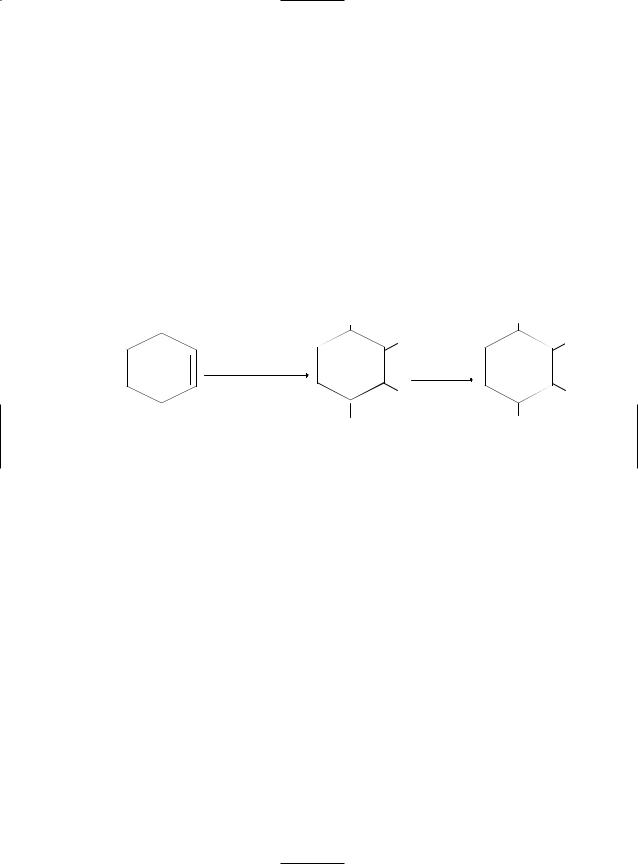
- •Caro’s Acid
- •Ceric Ammonium Nitrate
- •Cerium
- •Cerium(III) Chloride
- •Cerium(III) Hydroxide
- •Cerium(III) Nitrate
- •Cerium(IV) Oxide
- •Cerium(IV) Sulfate
- •Cesium
- •Cesium Chloride
- •Cesium Hydroxide
- •Chlorine
- •Chlorine Dioxide
- •Chlorine Monoxide
- •Chlorine Trifluoride
- •Chromium
- •Chromium(II) Chloride
- •Chromium(III) Chloride
- •Chromium Hexacarbonyl
- •Chromium(III) Hydroxide Trihydrate
- •Chromium(III) Fluoride
- •Chromium(III) Oxide
- •Chromium(VI) Oxide
- •Chromium(III) Sulfate
- •Chromyl Chloride
- •Cobalt
- •Cobalt(II) Acetate
- •Cobalt(II) Carbonate
- •Cobalt Carbonate, Basic
- •Cobalt(II) Chloride
- •Cobalt Complexes

228 CHROMIUM(III) SULFATE
reduced from +6 to +3 oxidation state.
Reaction with hydrochloric acid yields chromyl chloride:
CrO3 + 2HCl → CrO2Cl2 + H2O
A similar reaction occurs with HF to yield chromyl fluoride CrO2F2. However, fluorination with F2 yields the oxohalide, CrOF4.
Analysis
Elemental composition: Cr 52.00%, O 48.00%. The compound may be identified from its dark red color. Other color phases are noted above. Chromium may be measured in the aqueous phase by AA, ICP or x-ray techniques, or in the solid phase by x-ray methods. Hexavalent chromium (Cr6+) may be analyzed by ion chromatography. For this, the aqueous sample is adjusted to pH 9 to 9.5 with a concentrated buffer (ammonium sulfate and ammonium hydroxide mixture) and mixed into the eluent stream of the buffer. Cr6+ is separated from Cr3+ on a column, and derivatized with an azide dye as a colored product measured at 530 nm, which is identified from its retention time. (APHA, AWWA, and WEF. 1999. Standard Methods for The Examination of Water and Wastewater, 20th ed., Washington, DC: American Public Health Association.)
CHROMIUM(III) SULFATE
[10101-53-8]
Formula: Cr2(SO4)3; MW 392.16; several hydrates are known; these include the pentadecahydrate Cr2(SO4)3•15H2O and the octadecahydrate Cr2(SO4)3•18H2O
Synonym: chromic sulfate
Uses
Chromium(III) sulfate is used as the electrolyte for obtaining pure chromium metal. It is used for chrome plating of other metals for protective and decorative purposes. Other important applications of this compound are as a mordant in the textile industry; in tanning leather; to dissolve gelatin; to impart green color to paints, varnishes, inks, and ceramic glazes; and as a catalyst.
Physical Properties
Reddish-brown hexagonal crystal; the pentadecahydrate is a dark green amorphous substance while the octadecahydrate is a violet cubic crystal; the densities are 3.10 g/cm3 (the anhydrous salt), 1.87 g/cm3 (pentadecahydrate), 1.709/cm3 (octadecahydrate); the anhydrous sulfate is insoluble in water and acids; the hydrate salts are soluble in water; the pentadecahydrate is insoluble in alcohol, but the octadecahydrate dissolves in alcohol.

CHROMYL CHLORIDE 229
Preparation
Chromium(III) sulfate is prepared by treating chromium(III) hydroxide with sulfuric acid followed by crystallization:
2Cr(OH)3 + 3H2SO4 → Cr2(SO4)3 + 6H2O
Analysis
Elemental composition: Cr 26.72%; S 24.52%, O 48.95%. Chromium may be analyzed in the acid extract of the salt by various instrumentation techniques (see Chromium).
CHROMYL CHLORIDE
[14977-61-8]
Formula: CrO2Cl2; MW 154.90; tetrahedral structure, Cr=O bond distance 1.581 Å and Cr–Cl bond distance 2.126Å.
Synonyms: chromium dioxychloride; dichlorodioxochromium; chlorochromic anhydride.
Uses
Chromyl chloride is used in many organic synthetic reactions including oxidation and chlorination. It also is used as a catalyst in olefin polymerization; in the preparation of chromium complexes; and as a solvent for chromic anhydride.
Physical Properties
Dark red, fuming liquid; reddish yellow vapors; musty buring odor; density 1.91 g/mL; freezes at –96.5°C; boils at 117°C; reacts with water; soluble in chloroform, carbon tetrachloride, benzene, carbon disulfide and nitrobenzene.
Preparation
Chromyl chloride is prepared by reacting chromium(III) chloride with hydrochloric acid:
CrO3 + 2HCl → CrO2Cl2 + H2O
Also, it may be prepared by warming potassium dichromate with potassium chloride in concentrated sulfuric acid:
K2Cr2O7 + 4KCl + 3H2SO4 → 2Cr2O2Cl2 + 3K2SO4 + 3H2O
Reactions
Chromyl chloride reacts with water, hydrolyzing to CrO42– and HCl. The compound is sensitive to light but stable in the dark.
Chromyl chloride is a powerful oxidizing agent employed in organic syn-

230 CHROMYL CHLORIDE
thesis. It oxidizes toluene to benzaldehyde. The reaction is catalyzed by trace olefin.
CrO2Cl2 |
C6H5CHO |
C6H5CH3 → |
It reacts with olefins forming their chromyl chloride derivatives which on hydrolysis yield chloroalcohols (chlorohydrins) that are mostly the ß-chloro- primary alcohols:
RCH=CH2 |
CrO2Cl2 |
|
→ RCHClCH2OH |
||
|
hydrolysis |
(35–50% yield) |
|
|
|
Reaction with cyclohexene yields a trans– ß–chlorohydrin:
H |
H |
Cl |
Cl |
CrO2Cl2
H2O
|
H |
H |
|
|
|
OCrCl |
|
OH |
Chromyl chloride also oxidizes saturated hydrocarbons. For example, it oxidizes isobutane to tert-butyl chloride:
(CH ) CHCH CrO2Cl2 (CH ) CCl
3 2 3 → 3 3
and cyclohexane to chlorocyclohexane:
C H CrO2Cl2 C H Cl
6 12 → 6 11
Analysis
Elemental composition: Cr 33.57%, Cl 45.77%, O 20.66%. A trace amount may be dissolved in a suitable organic solvent and identified and measured quantitatively by GC–FID, GC–ECD, or by mass spectroscopy. For GC–ECD determination, use a nonchlorinated solvent. Chromium may be determined by AA or ICP techniques following thorough digestion in nitric acid.
Hazard
Chromyl chloride reacts violently with alcohol, ammonia, and turpentine, igniting these liquids. Reactions with other oxidiazable substances can be violent. The liquid is corrosive and possibly a poison. Skin contact can cause blisters. Exposure to its vapors causes severe irritation of the eyes, nose, and respiratory tract. Prolonged or excessive inhalation can cause death.

COBALT 231
COBALT
[7440-48-4]
Symbol: Co; atomic number 27; atomic weight 58.933; a transtion metal, Group VIII (Group 9) element; electron configuration [Ar]3d74s2; valence +2 and +3; also valences 0, +1, +4, and +5 are known; natural isotopes Co-59 (99.8%) and Co-57 (0.2%); radioactive isotope Co-60.
Occurrence and Uses
Cobalt has been in use as a coloring agent for glass since ancient times. The metal was isolated by Brandt in 1735 and confirmed as an element by Bergman in 1780. Cobalt is widely distributed in nature, but in small concentrations. Its concentration in the earth’s crust is estimated to be about 0.0025% and in the sea water is about 0.02 g/L. Cobalt minerals with their chemical formula and CAS Registry numbers are tabulated below:
Mineral |
CAS Registry |
Chemical Formula |
% |
cobaltite |
[1303-15-7] |
CoAsS3 |
35.5 |
carrolite |
[12285-42-6] |
CuCo2S4 |
38.7 |
cattierite |
[12017-06-0] |
CoS2(Co,Ni)S2 |
----- |
linnaeite |
[1308-08-3] |
Co3S4 |
48.7 |
siegenite |
[12174-56-0] |
(Co,Ni)3S4 |
26.0 |
erythrite |
[149-32-6] |
3CoO•As2O5•8H2O |
29.5 |
heterogenite |
[12323-83-0] |
CuO•2Co2O3•6H2O* |
57.0 |
asbolite |
[12413-71-7] |
CoO•2MnO2•4H2O |
----- |
safflorite |
[12044-43-8] |
CoAs2 (orthogonal) |
28.2 |
smaltite |
[12044-42-1] |
CoAs2 (cubic), (Co, Ni)As3 |
28.2 |
skutterudite |
[12196-91-7] |
CoAs3(Co,Ni)As3 |
20.8 |
* The ore contains varrying waters of crystalization.
Most cobalt found on earth is diffused into the rocks. It also is found in coal and soils, and at trace concentations in animals and plants. It is an essential element for plants and animals (as vitamin B12). Its absence in animals can cause retarded growth, anemia and loss of apetite. The element has been detected in meteorites and in the atmospheres of the sun and other stars.
The most imporant use of cobalt is in the manufacture of various wearresistant and superalloys. Its alloys have shown high resistance to corrosion and oxidation at high temperatures. They are used in machine components. Also, certain alloys are used in desulfurization and liquefaction of coal and hydrocracking of crude oil shale. Cobalt catalysts are used in many industrial processes. Several cobalt salts have wide commercial applications (see individual salts). Cobalt oxide is used in glass to impart pink or blue color. Radioactive cobalt–60 is used in radiography and sterilization of food.
Physical Properties
Silvery-white metal; occurs in two allotropic modifications over a wide

232 COBALT
range of temperatures–the crystalline closed-packed-hexagonal form is known as alpha form and a face-centered cubic form is the beta (or gamma) form. The alpha form predominates at temperatures up to 417°C and transforms to beta allotrope above this temperature; density 8.86 g/cm3; cast hardness (Brinnel) 124; melts at 1,493°C; vaporizes at 2,927°C; Curie temperature 1,121°C; electrical resistivity 5.6 microhm-cm at 0°C; Young’s modulus 211 Gpa (3.06x107psi); Poisson’s ratio 0.32; soluble in dilute acids.
Thermochemical Properties |
|
∆Hƒ°(cry) |
0.0 |
S° (cry) |
7.14 cal/degree mol |
Cρ (cry) |
5.93 cal/degree mol |
∆Hƒ°(g) |
101.51 kcal/mol |
∆Gƒ° (g) |
90.89 kcal/mol |
S° (g) |
42.90 cal/degree mol |
∆Hfus |
65.73 kcal/mol |
Coeff. linear expansion, 40°C |
1.336x10–5/°C |
Production
Cobalt is obtained from its ores, which are mostly sulfide, arsenic sulfide or oxide in nature. The finely ground ore is subjected to multistep processing, depending on the chemical nature of the ore.
When the sulfide ore carrollite, CuS•Co2S3, is the starting material, first sulfides are separated by flotation with frothers. Various flotation processes are applied. The products are then treated with dilute sulfuric acid producing a solution known as copper-cobalt concentrate. This solution is then electrolyzed to remove copper. After the removal of copper, the solution is treated with calcium hydroxide to precipitate cobalt as hydroxide. Cobalt hydroxide is filtered out and separated from other impurities. Pure cobalt hydroxide then is dissolved in sulfuric acid and the solution is again electrolyzed. Electrolysis deposits metallic cobalt on the cathode.
Production of cobalt in general is based on various physical and chemical processes that include magnetic separation (for arsenic sufide ores), sulfatizing roasting (for sulfide ores), ammoniacal leaching, catalytic reduction, and electrolysis.
Finely divided cobalt particles can be prepared by reduction of cobalt(II) chloride by lithium naphthalenide in glyme.
Reactions
Finely divided cobalt is pyrophoric. But the lump metal is stable in air at ordinary temperatures. It is oxidized on heating at 300°C to cobalt oxide.
Reactions with dilute mineral acids yield the corresponding Co2+ salts. With hydrochloric acid the reaction is slow. The metal liberates hydrogen from dilute mineral acids:
Co + 2HNO3 → Co(NO3)2 + H2
